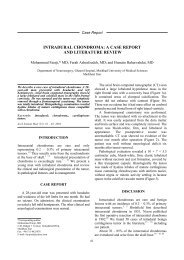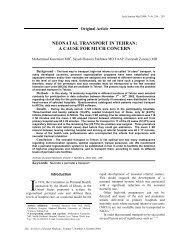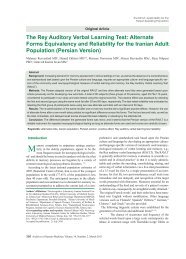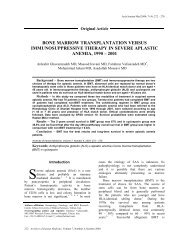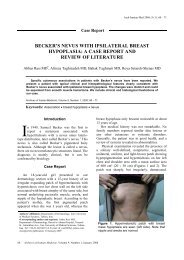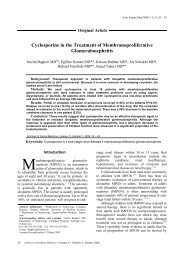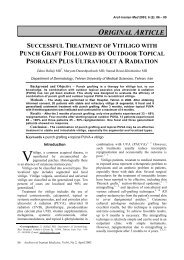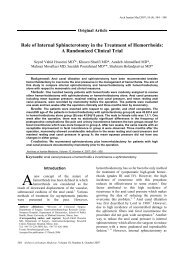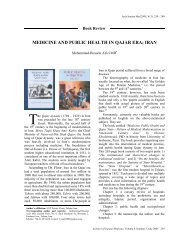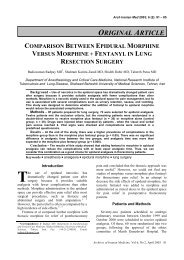the results of posterior sagittal anorectoplasty in anorectal ...
the results of posterior sagittal anorectoplasty in anorectal ...
the results of posterior sagittal anorectoplasty in anorectal ...
You also want an ePaper? Increase the reach of your titles
YUMPU automatically turns print PDFs into web optimized ePapers that Google loves.
Arch Iranian Med 2005; 8 (4): 272 – 276<br />
Orig<strong>in</strong>al Article<br />
THE RESULTS OF POSTERIOR SAGITTAL ANORECTOPLASTY<br />
IN ANORECTAL MALFORMATIONS<br />
Ahmad Khaleghnejad-Tabari MD • *, Mahmood Saeeda MD**<br />
Background: Posterior <strong>sagittal</strong> <strong>anorectoplasty</strong> (PSARP) is <strong>the</strong> newest and most-widely-used<br />
technique for correction <strong>of</strong> <strong>anorectal</strong> malformations (ARMs). In <strong>the</strong> present <strong>in</strong>vestigation, <strong>the</strong><br />
functional outcomes <strong>of</strong> PSARP and also <strong>the</strong> relationship between <strong>the</strong> complications and <strong>the</strong> sacral<br />
ratio (SR) have been studied.<br />
Methods: The study group <strong>in</strong>cluded 49 patients (25 males and 24 females) with ARMs,<br />
operated on by <strong>the</strong> PSARP technique dur<strong>in</strong>g 1995 – 1999. The patients had been followed up for at<br />
least 4 years. Those with mental retardation were not <strong>in</strong>cluded <strong>in</strong> this retrospective study. For<br />
objective evaluation <strong>of</strong> <strong>the</strong> sacrum, <strong>the</strong> SR was calculated <strong>in</strong> all <strong>of</strong> <strong>the</strong> patients.<br />
Results: In <strong>the</strong> female patients, rectovestibular fistula (46%) and <strong>in</strong> <strong>the</strong> males, per<strong>in</strong>eal fistula<br />
and imperforate anus without fistula, each with equal frequency (28%) were <strong>the</strong> most common<br />
anomalies. The mean SR <strong>in</strong> <strong>the</strong> study group was 0.72 + 0.04. SR was 0.67 + 0.03 among patients<br />
who had associated urogenital anomalies, 0.69 + 0.04 <strong>in</strong> patients suffer<strong>in</strong>g from soil<strong>in</strong>g, and 0.67 +<br />
0.02 <strong>in</strong> patients who had postoperative fecal <strong>in</strong>cont<strong>in</strong>ence. The most common complication<br />
follow<strong>in</strong>g PSARP was soil<strong>in</strong>g (44.9%) and <strong>the</strong>n constipation and fecal <strong>in</strong>cont<strong>in</strong>ence <strong>in</strong> order <strong>of</strong><br />
frequency. None <strong>of</strong> <strong>the</strong> cases developed ur<strong>in</strong>ary <strong>in</strong>cont<strong>in</strong>ence or o<strong>the</strong>r ur<strong>in</strong>ary complications after<br />
PSARP. Seventy-three percent <strong>of</strong> <strong>the</strong> patients had voluntary bowel movements (VBMs) and 51%<br />
were totally cont<strong>in</strong>ent.<br />
Conclusion: Although <strong>the</strong> PSARP has a negligible complication rate, <strong>the</strong> success and outcome<br />
<strong>of</strong> <strong>the</strong> surgical correction <strong>in</strong> view <strong>of</strong> <strong>the</strong> bowel function depend on <strong>the</strong> development <strong>of</strong> <strong>the</strong> sacral<br />
nerves. SR reflects <strong>the</strong> sacral bone development and can be easily calculated by a pelvic AP film.<br />
Consider<strong>in</strong>g <strong>the</strong> lower SR <strong>in</strong> patients suffer<strong>in</strong>g from postoperative sol<strong>in</strong>g and fecal <strong>in</strong>cont<strong>in</strong>ence, <strong>in</strong><br />
comparison to <strong>the</strong> normal group (0.77), SR could be used as a prognostic <strong>in</strong>dex to predict <strong>the</strong><br />
probability <strong>of</strong> achiev<strong>in</strong>g total cont<strong>in</strong>ence follow<strong>in</strong>g PSARP.<br />
Archives <strong>of</strong> Iranian Medic<strong>in</strong>e, Volume 8, Number 4, 2005: 272 – 276.<br />
Keywords: Anorectal malformations (ARMs) • imperforate anus • <strong>posterior</strong> <strong>sagittal</strong> <strong>anorectoplasty</strong><br />
(PSARP) • sacral ratio<br />
Introduction<br />
A<br />
norectal malformations (ARMs) are<br />
common anomalies encountered <strong>in</strong> <strong>the</strong><br />
neonatal period with a wide spectrum<br />
<strong>of</strong> presentations. S<strong>in</strong>ce 1982, <strong>the</strong> description <strong>of</strong><br />
<strong>posterior</strong> <strong>sagittal</strong> <strong>anorectoplasty</strong> (PSARP) by de<br />
Vries and Peňa, it has ga<strong>in</strong>ed popularity among<br />
pediatric surgeons and so PSARP is currently <strong>the</strong><br />
Authors’ affiliations: *Department <strong>of</strong> Pediatric Surgery, Shaheed<br />
Beheshti University <strong>of</strong> Medical Sciences, **Milad General<br />
Hospital, Iranian Social Security Organization, Tehran, Iran.<br />
•Correspond<strong>in</strong>g author and repr<strong>in</strong>ts: Ahmad Khaleghnejad –<br />
Tabari MD, Department <strong>of</strong> Pediatric Surgery, M<strong>of</strong>id Children’s<br />
Hospital, Tehran, Iran. Fax: +98-21-22251736.<br />
most-widely-used technique for correction <strong>of</strong><br />
ARMs. 1 – 4<br />
Consider<strong>in</strong>g that <strong>the</strong> functional outcomes <strong>of</strong><br />
PSARP have not yet been assessed <strong>in</strong> Iran, this<br />
study reviews both <strong>in</strong>traoperative and<br />
postoperative complications <strong>of</strong> this technique<br />
along with <strong>the</strong> relationship between sacral ratio<br />
(SR) and later functional problems such as fecal<br />
<strong>in</strong>cont<strong>in</strong>ence and soil<strong>in</strong>g.<br />
Materials and Methods<br />
Between 1995 – 1999, at <strong>the</strong> Department <strong>of</strong><br />
Pediatric Surgery, M<strong>of</strong>id Children’s Hospital, 49<br />
patients <strong>in</strong>clud<strong>in</strong>g 25 boys (51%) and 24 girls<br />
272<br />
Archives <strong>of</strong> Iranian Medic<strong>in</strong>e, Volume 8, Number 4, October 2005
A. Khaleghnejad-Tabari, M. Saeeda<br />
Figure 1. Sacral ratio <strong>in</strong> <strong>the</strong> AP view. The transverse l<strong>in</strong>es are drawn across <strong>the</strong> uppermost portion <strong>of</strong> iliac<br />
crests, <strong>posterior</strong> iliac sp<strong>in</strong>es, and <strong>the</strong> lowermost radiologically visible po<strong>in</strong>t <strong>of</strong> sacrum (SR = a/b).<br />
(49%) who had suffered from some forms <strong>of</strong><br />
ARMs and treated by a surgeon, were <strong>in</strong>cluded <strong>in</strong><br />
this study.<br />
All <strong>of</strong> <strong>the</strong> patients with high-type anomalies (37<br />
cases), underwent a divided loop high sigmoid<br />
colostomy via a curved <strong>in</strong>cision <strong>in</strong> <strong>the</strong> left lower<br />
quadrant with taper<strong>in</strong>g <strong>of</strong> <strong>the</strong> distal stoma, as<br />
mucous fistula positioned at <strong>the</strong> medial corner <strong>of</strong><br />
<strong>the</strong> <strong>in</strong>cision and a proximal maturated stoma at <strong>the</strong><br />
uppermost portion <strong>of</strong> <strong>the</strong> <strong>in</strong>cision. We rout<strong>in</strong>ely<br />
fixed <strong>the</strong> seromuscular coat <strong>of</strong> <strong>the</strong> bowel only to<br />
<strong>the</strong> peritoneum (silk) and subcutaneous layer <strong>of</strong> <strong>the</strong><br />
sk<strong>in</strong>, with an absorbable suture material.<br />
While perform<strong>in</strong>g a thorough evaluation to rule<br />
out <strong>the</strong> associated urogenital, cardiovascular,<br />
skeletal, and vertebral anomalies, <strong>the</strong> SR <strong>of</strong> every<br />
patient was calculated and <strong>the</strong>n under optimal<br />
conditions <strong>the</strong> patients underwent PSARP. Figure<br />
1 shows <strong>the</strong> SR <strong>of</strong> a normal pelvis <strong>in</strong> an<br />
antero<strong>posterior</strong> (AP) film.<br />
All records <strong>of</strong> <strong>the</strong> cases were reviewed and <strong>the</strong><br />
early and late postoperative complications<br />
(urologic and gastro<strong>in</strong>test<strong>in</strong>al) were assessed<br />
dur<strong>in</strong>g <strong>the</strong> follow-up visits. The three parameters<br />
<strong>of</strong> bowel function used <strong>in</strong> this study were: 1)<br />
voluntary bowel movements (VBMs), 2) soil<strong>in</strong>g,<br />
and 3) constipation.<br />
Also, <strong>the</strong> relationship between SR and<br />
functional complications was evaluated and a<br />
comparison between <strong>the</strong> groups was carried out by<br />
Rectovestibular fistula,<br />
46%<br />
IA without<br />
fistula, 4%<br />
Per<strong>in</strong>eal fistula,<br />
21%<br />
Rectovag<strong>in</strong>al<br />
fistula, 21%<br />
Rectal atresia,<br />
4%<br />
Persistent<br />
cloaca, 4%<br />
Figure 2. Types <strong>of</strong> anomalies <strong>in</strong> <strong>the</strong> female patients. IA = imperforate anus.<br />
Archives <strong>of</strong> Iranian Medic<strong>in</strong>e, Volume 8, Number 4, October 2005 273
The <strong>results</strong> <strong>of</strong> PSARP <strong>in</strong> ARMs<br />
IA without fistula,<br />
28%<br />
Per<strong>in</strong>eal fistula, 28%<br />
RU prostatic fistula,<br />
4%<br />
RU bulbar fistula,<br />
20%<br />
Rectovesical fistula,<br />
20%<br />
Figure 3. Types <strong>of</strong> anomalies <strong>in</strong> <strong>the</strong> male patients. IA = imperforate anus; RU = rectourethral.<br />
t-test, us<strong>in</strong>g <strong>the</strong> SPSS statistical package and P<br />
values <strong>of</strong> less than 0.05 were considered as<br />
significant.<br />
The duration <strong>of</strong> follow-up was from 4 to 8<br />
years.<br />
Results<br />
The most common anomalies encountered <strong>in</strong><br />
<strong>the</strong> female patients were rectovestibular and <strong>the</strong>n<br />
per<strong>in</strong>eal fistulas. Figure 2 shows <strong>the</strong> frequency <strong>of</strong><br />
anomalies <strong>in</strong> <strong>the</strong> female patients. In <strong>the</strong> male<br />
patients, <strong>the</strong> most common malformations were<br />
per<strong>in</strong>eal fistula and imperforate anus without<br />
fistula (Figure 3).<br />
Forty-one percent <strong>of</strong> <strong>the</strong> patients had associated<br />
anomalies and this frequency was higher among<br />
patients with high-type malformations (51%). On<br />
<strong>the</strong> o<strong>the</strong>r hand, only 8.3% <strong>of</strong> <strong>the</strong> patients with<br />
per<strong>in</strong>eal fistula had associated anomalies. The most<br />
frequent associated anomalies were, <strong>in</strong> order <strong>of</strong><br />
frequency, urogenital, skeletal, cardiovascular, and<br />
gastro<strong>in</strong>test<strong>in</strong>al defects.<br />
Dur<strong>in</strong>g PSARP no <strong>in</strong>jury to <strong>the</strong> ureters, vas<br />
deferens, or o<strong>the</strong>r parts <strong>of</strong> ur<strong>in</strong>ary system occurred.<br />
Early postoperatively, stenosis <strong>of</strong> neoanus<br />
developed <strong>in</strong> 6 patients (12.2%) which was treated<br />
by dilatation and bougienage <strong>in</strong> one case, cutback<br />
appeared <strong>in</strong> ano<strong>the</strong>r one, and Y-V anoplasty <strong>in</strong> four<br />
o<strong>the</strong>r patients.<br />
None <strong>of</strong> <strong>the</strong> patients developed wound<br />
<strong>in</strong>fection, mucosal prolapse, dehiscense <strong>of</strong><br />
Mean SR<br />
0.74<br />
0.73<br />
0.72<br />
0.71<br />
0.7<br />
0.69<br />
0.68<br />
0.67<br />
0.66<br />
0.65<br />
0.64<br />
0.73<br />
Without UG anomalies<br />
0.67<br />
With UG anomalies<br />
Figure 4. Sacral ratio <strong>in</strong> patients with and without associated urogenital (UG) system anomalies (P <<br />
0.05).<br />
274<br />
Archives <strong>of</strong> Iranian Medic<strong>in</strong>e, Volume 8, Number 4, October 2005
A. Khaleghnejad-Tabari, M. Saeeda<br />
Mean SR<br />
0.76<br />
0.75<br />
0.74<br />
0.73<br />
0.72<br />
0.71<br />
0.7<br />
0.69<br />
0.68<br />
0.67<br />
0.66<br />
0.75<br />
Without soil<strong>in</strong>g<br />
0.69<br />
With Soil<strong>in</strong>g<br />
Figure 5. Sacral ratio <strong>in</strong> patients with and without soil<strong>in</strong>g (P < 0.05).<br />
anastomosis, or transient femoral nerve palsy<br />
follow<strong>in</strong>g PSARP.<br />
Among postoperative urologic complications,<br />
none <strong>of</strong> our cases developed any form <strong>of</strong><br />
complications like ur<strong>in</strong>ary <strong>in</strong>cont<strong>in</strong>ence, urethral<br />
stricture, or recurrence <strong>of</strong> fistula.<br />
Two patients (4%) had “aganglionic bowel”,<br />
confirmed by histopathologic reports. They<br />
underwent <strong>anorectal</strong> myectomy and one <strong>of</strong> <strong>the</strong>m<br />
who did not respond to this procedure, was treated<br />
by pullthrough (Soave) procedure. Both <strong>of</strong> <strong>the</strong>se<br />
cases <strong>of</strong> Hirschsprung’s disease have normal bowel<br />
habit now.<br />
The most frequent bowel function<br />
complications were soil<strong>in</strong>g (44.9%), constipation<br />
(30.6%), and fecal <strong>in</strong>cont<strong>in</strong>ence (26.5%).<br />
Total cont<strong>in</strong>ence was present <strong>in</strong> 51% <strong>of</strong> <strong>the</strong><br />
patients after PSARP.<br />
The mean SR was 0.72 ± 0.04 among our cases.<br />
The normal SR is considered to be 0.77. SR <strong>of</strong> <strong>the</strong><br />
patients with associated ur<strong>in</strong>ary system anomalies<br />
was 0.67 ± 0.03 (Figure 4).<br />
The patients who developed soil<strong>in</strong>g and fecal<br />
<strong>in</strong>cont<strong>in</strong>ence had SR <strong>of</strong> 0.69±0.04 and 0.67 ± 0.02,<br />
respectively (Figures 5 and 6). There was no<br />
significant difference between SR <strong>of</strong> <strong>the</strong> patients<br />
with postoperative constipation and those patients<br />
who did not develop this problem.<br />
Discussion<br />
No urologic complication developed after<br />
PSARP <strong>in</strong> our cases .In one study, <strong>the</strong> <strong>in</strong>cidence <strong>of</strong><br />
ureteric or vas <strong>in</strong>jury was 0.18% and ur<strong>in</strong>ary<br />
<strong>in</strong>cont<strong>in</strong>ence 9.3%. 3 – 5 The reported 0.45%<br />
<strong>in</strong>cidence <strong>of</strong> wound <strong>in</strong>fection after PSARP was<br />
never seen <strong>in</strong> our patients. 4<br />
Follow<strong>in</strong>g PSARP, 12.7% <strong>of</strong> our patients<br />
0.76<br />
0.74<br />
0.74<br />
Mean SR<br />
0.72<br />
0.7<br />
0.68<br />
0.66<br />
0.64<br />
0.67<br />
0.62<br />
With fecal cont<strong>in</strong>ence<br />
Without fecal cont<strong>in</strong>ence<br />
Figure 6. Sacral ratio <strong>in</strong> patients with and without fecal cont<strong>in</strong>ence (P < 0.05).<br />
Archives <strong>of</strong> Iranian Medic<strong>in</strong>e, Volume 8, Number 4, October 2005 275
The <strong>results</strong> <strong>of</strong> PSARP <strong>in</strong> ARMs<br />
developed anal stenosis. In one study, 30% <strong>of</strong> <strong>the</strong><br />
patients had this problem after PSARP. 6<br />
While <strong>the</strong> <strong>in</strong>cidence <strong>of</strong> mucosal prolapse has<br />
been reported to be 23%, none <strong>of</strong> our patients<br />
developed this complication. 6<br />
The bowel function <strong>of</strong> each patient was<br />
evaluated <strong>in</strong>dependent <strong>of</strong> any medical treatment,<br />
such as <strong>the</strong> use <strong>of</strong> suppositories, laxatives, or<br />
enemas. VBMs are def<strong>in</strong>ed as <strong>the</strong> act <strong>of</strong> feel<strong>in</strong>g <strong>the</strong><br />
urge to use <strong>the</strong> toilet for a bowel movement and <strong>the</strong><br />
capacity to verbalize it and to hold it until <strong>the</strong><br />
patient reaches <strong>the</strong> bathroom. Soil<strong>in</strong>g is def<strong>in</strong>ed as<br />
<strong>the</strong> <strong>in</strong>voluntary leakage <strong>of</strong> small amounts <strong>of</strong> stool,<br />
which produces smear<strong>in</strong>g <strong>of</strong> <strong>the</strong> underwear.<br />
Constipation is <strong>the</strong> <strong>in</strong>capacity to empty <strong>the</strong> rectum<br />
spontaneously (without help) everyday.<br />
Patients who had VBMs and never soiled, were<br />
considered totally cont<strong>in</strong>ent. 5 The <strong>in</strong>cidence <strong>of</strong><br />
soil<strong>in</strong>g and constipation <strong>in</strong> our study group was<br />
lower than <strong>the</strong> o<strong>the</strong>r studies, which have reported<br />
values <strong>of</strong> 57% and 43.1%, respectively. However,<br />
fecal <strong>in</strong>cont<strong>in</strong>ence was similar to <strong>the</strong> <strong>results</strong> <strong>of</strong><br />
o<strong>the</strong>r studies (26%). 3 – 8<br />
Seventy-three percent <strong>of</strong> our patients had<br />
VBMs, which correspond to <strong>the</strong> <strong>results</strong> <strong>of</strong> o<strong>the</strong>r<br />
studies (74.3%). 3 – 7 Fifty-one percent <strong>of</strong> <strong>the</strong> cases<br />
<strong>in</strong> our study were totally cont<strong>in</strong>ent, whereas this<br />
value is between 35% and 58% <strong>in</strong> o<strong>the</strong>r<br />
studies. 3 – 10<br />
As <strong>in</strong> o<strong>the</strong>r studies, soil<strong>in</strong>g and fecal<br />
<strong>in</strong>cont<strong>in</strong>ence were more prevalent <strong>in</strong> high anomaly<br />
cases and constipation was more common <strong>in</strong> <strong>the</strong><br />
low-type anomalies. 5 – 11<br />
SR is <strong>in</strong>dicative <strong>of</strong> sacral bone and nerve<br />
development. The SR value <strong>of</strong> our patients was<br />
lower than <strong>the</strong> normal value. This ratio was even<br />
significantly lower <strong>in</strong> <strong>the</strong> cases with concomitant<br />
ur<strong>in</strong>ary system anomalies, those with postoperative<br />
soil<strong>in</strong>g, and fecal <strong>in</strong>cont<strong>in</strong>ence. 7<br />
Consider<strong>in</strong>g <strong>the</strong> low mortality and complication<br />
rates along with acceptable function <strong>results</strong>, it<br />
seems that PSARP is a fully-suitable, safe, and<br />
effective method for surgical correction <strong>of</strong><br />
<strong>anorectal</strong> malformations.<br />
References<br />
1 Peňa A, de Vries PA. Posterior <strong>sagittal</strong> <strong>anorectoplasty</strong>,<br />
important technical considerations and new applications.<br />
J Pediatr Surg. 1982; 17: 796 – 811.<br />
2 de Vries PA, Peňa A. Posterior <strong>sagittal</strong> <strong>anorectoplasty</strong>. J<br />
Pediatr Surg. 1982; 17: 638 – 643.<br />
3 Kiely EM, Peňa A. Anorectal malformations. In: O’Neill<br />
JA, Rowe MI, Grosfeld JL, et al, eds. Pediatric Surgery.<br />
5th ed. St. Louis: Mosby; 1998: 1425 – 1448.<br />
4 Peňa A. Imperforate anus and cloacal malformations. In:<br />
Ashcraft KW, Holder TM, eds. Pediatric Surgery. 2nd<br />
ed. Philadelphia: Saunders; 2000: 473 – 492.<br />
5 Peňa A. Anorectal malformations: experience with <strong>the</strong><br />
<strong>posterior</strong> <strong>sagittal</strong> approach. In: Str<strong>in</strong>ger MD, Oldham KT,<br />
Mouriquand PDE, et al, eds. Pediatric Surgery and<br />
Urology. Philadelphia: Saunders; 1998: 376 – 385.<br />
6 Nixon HH, Puri P. The <strong>results</strong> <strong>of</strong> treatment <strong>of</strong> <strong>anorectal</strong><br />
anomalies: a thirteen- to twenty- year follow-up.<br />
J Pediatr Surg. 1977; 12: 27.<br />
7 Peňa A. Results <strong>in</strong> <strong>the</strong> management <strong>of</strong> 322 cases <strong>of</strong><br />
<strong>anorectal</strong> malformations. Pediatr Surg Int. 1988; 3:<br />
105 – 109.<br />
8 Peňa A. Anorectal malformation. Sem<strong>in</strong> Pediatr Surg.<br />
1995; 4: 35 – 47.<br />
9 Gil-Vernet JM, Asensio M, Marhuenda C, et al. N<strong>in</strong>eteen<br />
years enperience with <strong>posterior</strong> <strong>sagittal</strong> <strong>anorectoplasty</strong> as<br />
a treatment <strong>of</strong> <strong>anorectal</strong> malformations. Cir Pediatric.<br />
2001; 14: 108 – 111.<br />
10 Mart<strong>in</strong>s JL, Lederman HM, P<strong>in</strong>us J. Cl<strong>in</strong>ical and<br />
radiological postoperative evaluation <strong>of</strong> <strong>posterior</strong> <strong>sagittal</strong><br />
<strong>anorectoplasty</strong> <strong>in</strong> patient with upper and <strong>in</strong>termediate<br />
<strong>anorectal</strong> malformations. Rev Paul Med. 1997; 115:<br />
1566 – 1569.<br />
11 R<strong>in</strong>tala R, L<strong>in</strong>dahl H, Louhimo I. Anorectal<br />
malformations: result <strong>of</strong> treatment and long-term followup<br />
<strong>in</strong> 208 patients. Pediatr Surg Int. 1991; 6: 36.<br />
276<br />
Archives <strong>of</strong> Iranian Medic<strong>in</strong>e, Volume 8, Number 4, October 2005



